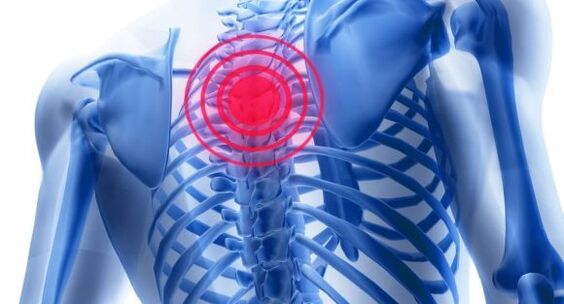
Thoracic osteochondosis- This is a dystrophic change in the intervertebral discs, located in the thoracic spine.The treatment of the disease is necessary to start immediately after making a diagnosis, since the disease can quickly go to a chronic form.
The main symptoms of the disease are the limitation of the mobility of the shoulder belt, the lack of breath, the discomfort in the stomach and the pain in the chest that give in the heart.The danger to the patient is that the symptoms of osteocondrosis are often confused with cardiovascular diseases, therefore therapy is carried out by incorrect disease.
The causes of osteochondosis
The thoracic osteochondrosis occurs following pathological changes in the vertebrae and intervertebral discs, as well as the contribution and compromised nutrition.In addition, the disease can be caused by the deformation of the spine.
Above all often, people who find themselves in a sedentary position suffer from the symptoms of the mammary osteocondrosis.Basically, these are employees and students of different ages.Due to the constant session without observing the correct position of the body, the load on the vertebrae increases significantly, which causes their deformation.
The radical causes of the disease:
- load increased on the spine that occurs when lifting weights
- Changes related to age in the body
- overweight
- injuries of the spinal department
- Genetic predisposition
Depending on the stage of symptoms, it is divided into 2 clinical cases.In the first case, the pain suddenly appears and has an acute form (the so -called "lateral").In the second case, the pain is long and is often accompanied by the rigidity of the cervical and chest column.The pain for the breast osteochondrosis limits the mobility of the back and also causes difficulty breathing.
The treatment of osteocondrosis of the thoracic region is carried out using complex methods and patterns, whose compilation depends on the stage of the disease, its course and the causes.Only a highly qualified specialist is able to cope with this task.
Disease phase
The first stadiumIt is characterized by the appearance of local pain due to muscle departure (thoracalgia).In addition, in the first phase there is a tension of the paragraded muscles of the back, which leads to an increase in pain and limitation of the mobility of the spine.
The second stageIt is accompanied by an increase in pain syndrome, since the nerve roots are involved in the inflammatory process.Also in this phase the protrusion and/or hernias of the intervertebral records (MPD) appear.
The third phaseIt causes constant pains that occur in the area of the nerve concerned.There is a change in the pace, numb in the limbs, the appearance of the headache, the breathing difficulty and the failure of the heart rhythm.This is due to the demonstration of significant deformations of the intervertebral disc and the spine.The risk of kidnapping increases clearly (the seizure is the separation of the Arnia and its movement along the spine, which damages the nerve roots associated with the spinal cord).And this in 90% of cases leads to surgery.
ONFourth phaseDiseases interrupt the functions of the intervertebral disc.The bone growth of vertebral bodies begins to connect the vertebrae close to each other.The osteochondrosis of the spine often causes a violation of the blood supply to the spinal cord.This phase of the disease is the most dangerous, since without timely therapy leads to disability.
Treatment
Before proceeding with the treatment, the diagnosis is carried out to detect the stage of the disease (initial, acute or chronic).Depending on the existing symptoms, therapy methods are selected.
The treatment of osteocondrosis of the thoracic region is more effective in the initial phases, when pathological changes are not so clearly expressed and reversible.
The main sign in which the disease passed through the acute phase is incessant painful sensations;Back muscles, chest and spine.In this phase of the development of osteocondrosis, the doctor's priority task is to relieve pain.














































